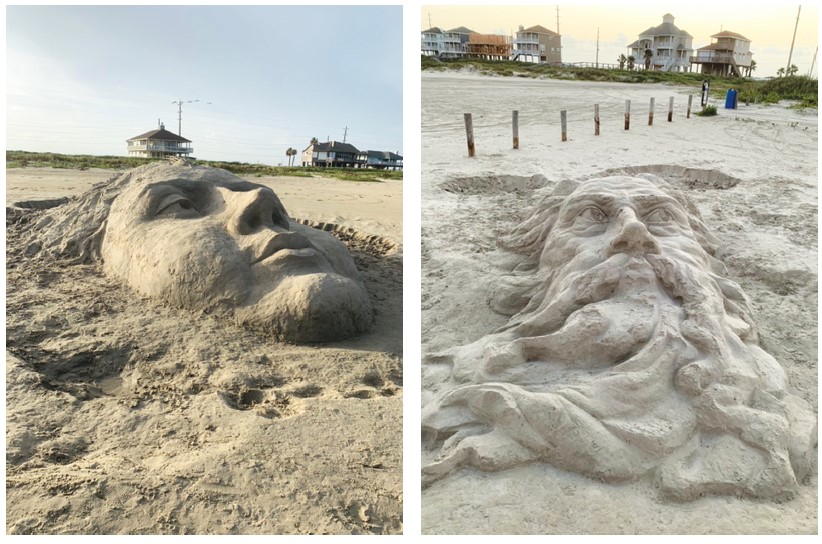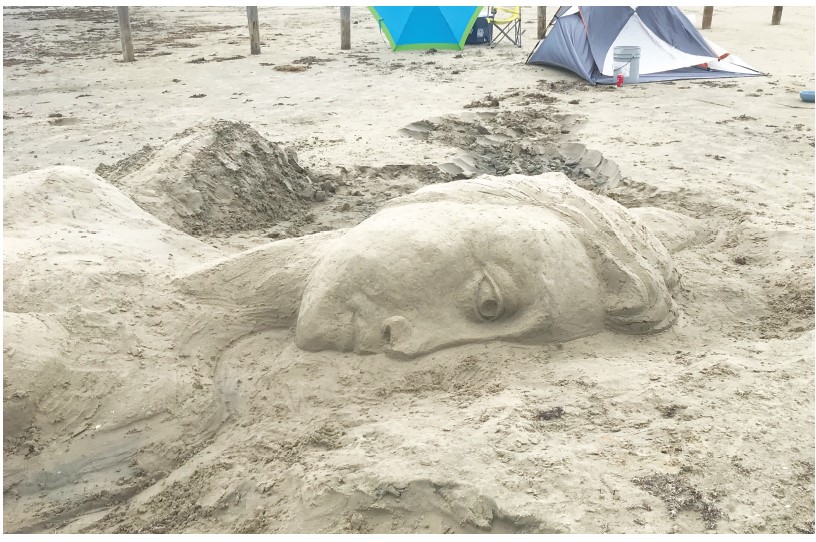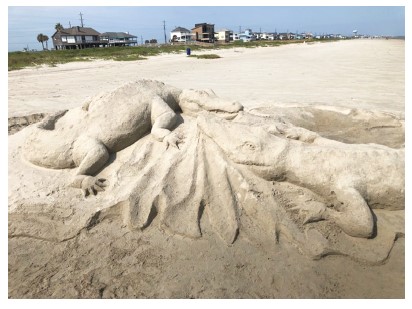Having never lived by the sea, Turkish sculptor Cevat Bezergenli learned about tidal patterns the hard way when he emerged one morning from his temporary weekend residence—a tent on West Beach—to find that the high tide had engulfed the sand sculpture he worked on for hours the day prior. He chuckles softly when recalling the experience, because after all, it was perfectly symbolic of the very reason he chose to sculpt along the shoreline in the first place.

“What sand sculpture means to me, is that—all of the time I spent, eleven years, traveling from my hometown—whatever I made, I left it. All the sculptures I made in different studios, I left them,” he recalls wistfully.
Cevat says that these losses taught him an important lesson about being an artist, “We don’t always need to make sculpture to keep it.”

Cevat’s Turkish ancestry made him part of the minority population where he grew up in northern Iran, just south of Azerbaijan. For years, he was embroiled in the political unrest that arose from de facto discrimination against his people and was a fierce advocate for the liberation of the Turkish people.
“I just wanted them to be able to leave and to travel, like you can here,” he says. Although he is not fluent in English, his command is great enough to convey the sincere love he still holds for his countrymen. “I want that for everyone.”
 Encouraged and mentored during this time by his brother, Cevat discovered his innate talent for sculpting. “My brother is a gifted architect, and he is the one who told me, ‘you should be a sculptor,’” he explains.
Encouraged and mentored during this time by his brother, Cevat discovered his innate talent for sculpting. “My brother is a gifted architect, and he is the one who told me, ‘you should be a sculptor,’” he explains.
Cevat’s brother trained him in Classical sculpture and later directed him to find a way to leave the country. “He told me, ‘You will never be able to create the kind of sculptures you want here.’ Because of the religion and government, I couldn’t sculpt what I wanted, I couldn’t paint what I wanted.” Thus began Cevat’s long journey to America.
“I went to the United Nations Embassy, and they told me that they could place me somewhere. But they did not know where,” he says.
So Cevat later took refuge in Turkey where he worked for various art studios and a university. After five long years of preparing for his yet uncertain future, he finally received the call.
“
They said, ‘You are going to the United States.’ So, after hiring a lawyer and paying lots of money,” he laughs, “I finally got to America.” One of his advisors recommended that he go to Houston, because there he would find a big-city art scene without the brutal winters of other major cities in the U.S.
Cevat recalls the exact date that he arrived in the Bayou City, April 25, 2017. He took a job with an electrician to make ends meet and gain a foothold in his new home, and then slowly he began to work his way back to his artistic career. He found work designing and creating artwork for custom cars, and from there he was introduced to the potential for his talents within the realm of interior design.
He first intended only to sculpt, creating elegant, detailed reliefs and ornamental archways for homes. “But then I learned that people in this country prefer more of the two-dimensional work for their homes,” he explains of discovering the demand for wall and ceiling treatments as well as murals. “And so, I learned that,” he says frankly, for at least the third time.
Every time life has demanded something from him—a new skill, a new medium, a new language or a new life—Cevat rose to the challenge and simply taught himself how to do it. He has learned enough to sustain a successful interior design business that creates unique, hand-painted and hand-sculpted design elements, including faux finishes on tile. But his most recent acquisition of knowledge was something he did only for himself.
This past summer, Cevat’s latest artistic journey acquainted him with the sands of Galveston’s beach where he was inspired to learn and create sand sculpture. Cevat does not drive, so on weekends when the weather is suitable, he pays a friend to bring him from Houston to the west end where he sets up camp and his earthly canvas.
In the beginning, there was some trial and error that of course included learning about the transience of the tides, but Cevat worked through the night, illuminated only by a flashlight to complete his first sculpture of Zeus.
Aside from being an iconic Classical image, Cevat was delighted to discover that the King of the Gods was a recognizable figure in the U.S. “Zeus is very widely known in my culture, and then I came here and saw that most everyone knew who Zeus was here, too,” he says.
In an unfamiliar land, surrounded by unfamiliar people, Cevat was encouraged by this commonality and the reminder that images require no translation.
Over the course of summer 2020, Cevat completed five different massive sand sculptures, sacrificing not only modern conveniences but also the satisfaction of being able to keep what he created. Instead, he derives the greater pleasure of peace from his work in Galveston and a solace that his talent will never be washed away. Cevat plans to continue his treks to the island indefinitely, whenever time and weather permit.
His ultimate goal is to have his art sold at auctions, and to this end he also continues to create studio work in his Classical style. Unsurprisingly, Cevat finds inventive ways to express the genre; his most recent mashup of mediums is acrylic on wood.
He describes his penchant for mythological and classical subjects as “realist but dematerialized. They are real, but they are not real,” he explains.
Arguably, those exact words could be used to describe the otherworldly emotions of sitting on the beach watching the sunrise. Or the feeling of creating art, simply for the sake of Art.
Follow Cevat Bezergenli on Instagram @cevadbzg. To contact Cevat directly or for more information on his studio and interior work, visit www.CevatArtist.com. To view his sand sculptures, look for Cevat on fair-weather weekends near Beach Access 35 near 24087 Termini San Luis Pass Road, Galveston, TX 77554. It's near Stavenger Beach, where the last water tower is located before Point West.